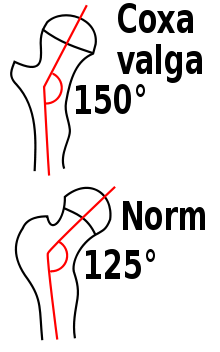- Coxa vara
-
Klassifikation nach ICD-10 Q65.8 Sonstige angeborene Deformitäten der Hüfte
- Coxa vara
- Coxa valgaM21.05 Valgusdeformität, anderenorts nicht klassifiziert
-HüftgelenkM21.15 Varusdeformität, anderenorts nicht klassifiziert
-HüftgelenkICD-10 online (WHO-Version 2011) Von einer Coxa vara (lat. coxa „Hüfte“, varus „auswärtsgebogen“) spricht man, wenn der CCD-Winkel, das heißt der Winkel zwischen Oberschenkelhals und Schaft des Oberschenkelknochens, unter 120° liegt. Sie kommt häufig bei älteren Menschen vor und erhöht die Wahrscheinlichkeit eines Oberschenkel-Halsbruchs (Schenkelhalsfraktur), da die Stabilität des Oberschenkelhalses (Collum ossis femoris) mit kleinerem CCD-Winkel abnimmt, also ein Ungleichgewicht von Belastung und Widerstandsfähigkeit herrscht. Weiterhin bedingt die Auswärtsstellung der Oberschenkelknochens eine Einwärtsstellung der Knie und damit die typische X-Beinstellung (genu valga). Coxa vara können sowohl aus genetischer Disposition, Lösung der Oberschenkelknochenkernes, knochenerweichenden Systemerkrankungen (z.B. Rachitis), Morbus Perthes, in falscher Stellung verheilten Oberschenkelfrakturen als auch aus übermäßiger Belastung resultieren.
Das Gegenteil ist die Coxa valga, die häufig bei Kleinkindern und Neugeborenen auftritt und eine Vergrößerung des CCD-Winkels auf mehr als 135° darstellt.

Bitte den Hinweis zu Gesundheitsthemen beachten!
Wikimedia Foundation.

